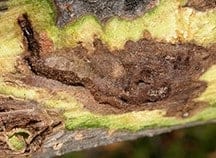Researchers from Purdue and Colorado State universities have discovered that the fungus responsible for thousand cankers disease, a lethal affliction of walnut trees and related species, has a rich genetic diversity that may make the disease more difficult to control.
Adjunct assistant professor of forestry Keith Woeste and fellow researchers analyzed the genes of 209 samples of Geosmithia morbida from 17 regions of the U.S. to determine the genetic diversity of the fungus, its possible origin and how it spread throughout the West and to parts of the East.
The researchers identified 57 distinct haplotypes, or genetic races, among the samples, a curious finding for an organism that reproduces by cloning itself. The high diversity of Geosmithia morbida likely indicates that the fungus mutates readily, said Woeste, who is also a hardwood specialist with the U.S. Forest Service.
“The high mutability of this fungus means we can expect the unexpected,” he said. “We can’t count on the fungus’ genes to be the same year after year, which certainly makes it harder to control. It will also be harder to breed trees resistant to this disease.”
First reported in the early 1990s, thousand cankers disease is deadly to black walnut trees and their relatives, such as butternut and wingnut trees. Black walnut trees are prized for their dark, high-quality wood and play a valuable role in the forest ecosystem as a food source for wildlife.
A tree becomes infected with the disease when walnut twig beetles, natural carriers of Geosmithia morbida, burrow deep into its bark, carving out finger-shaped “galleries.” The fungus spreads into the galleries, forming multiple cankers in the wood, which eventually leads to the tree’s death.
The disease has been found in trees throughout the Western U.S. and in several Eastern states, including Tennessee, Virginia, Pennsylvania and Ohio. It has also been found in Italy. Similar to emerald ash borer, the disease is spread primarily through the transportation of infested wood.
A single log can contain thousands of walnut twig beetles and multiple haplotypes of Geosmithia morbida, Woeste said. Spotting infested wood is difficult due to the small size of the beetles – “about the size of pepper flakes,” he said – and the fact that the cankers lie hidden beneath the bark.
“It would be almost impossible to know if a log was infested unless you started peeling the bark away,” Woeste said. “There probably isn’t going to be a way to get thousand cankers disease out of our forests in the East, but there might be ways to control it. Sanitation, attentiveness and care are just going to become part of the everyday routine for forest landowners.”
The study showed that thousand cankers disease likely originated in Southern California, rather than Arizona or New Mexico as researchers previously thought. The study also revealed that Geosmithia morbida is native to the U.S., as is the walnut twig beetle. Woeste said the fungus and beetle might have caused only minor damage to trees in the West for thousands of years before suddenly emerging as an important pathogen.
“This is an example of evolution that surprised us,” he said. “I don’t think anyone could have predicted this explosion out of what must have been small, isolated pockets of this beetle and fungus living in harmony with the ecosystem in the Southwest for many years. What forces drove that change, we don’t know.”
Future research could help determine why the fungus became so aggressive toward its host trees, he said.
Woeste advised landowners and companies that use and transport wood to stay informed.
“It’s too early to panic,” he said. “There’s still a lot of walnut in the U.S., and there’s going to be for a long time. However, people should stay abreast of changes as we continue to learn more about this disease and how landowners and companies can protect their resources.”
Information about the disease and resources for homeowners, industry and researchers can be found at http://www.thousandcankers.com.
The study was published in PLoS ONE on Thursday (Nov. 13).
The research was supported by funds provided through two grant programs of the U.S. Department of Agriculture’s National Institute of Food and Agriculture – the Western Region Integrated Pest Management Program Center and Critical Issues: Emerging and New Plant and Animal Pests and Diseases. Additional funding was provided by the Forest Health Monitoring Program and a Special Technology Development Grant, both from the U.S. Department of Agriculture’s Forest Service.


